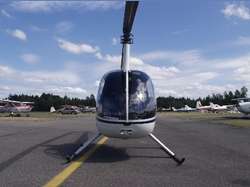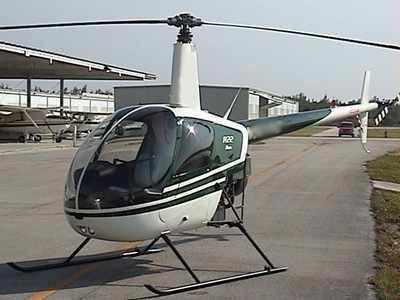 On the same day that a
Kemper Aviation C172 went down, a lone R22 also went down, with the
tragic loss of the pilot, a local firefighter. Please note details
that involve both parts of the rotor blades as well as the tail
boom being found some 350 feet from the base impact site... which
sure suggests the possibility of a rotor/boom strike.
On the same day that a
Kemper Aviation C172 went down, a lone R22 also went down, with the
tragic loss of the pilot, a local firefighter. Please note details
that involve both parts of the rotor blades as well as the tail
boom being found some 350 feet from the base impact site... which
sure suggests the possibility of a rotor/boom strike.
NTSB Identification: NYC08FA134
14 CFR Part 91: General Aviation
Accident occurred Thursday, March 13, 2008 in Wilmington, NC
Aircraft: Robinson R22 Beta II, registration: N2215R
Injuries: 1 Fatal.
This is preliminary information, subject to change, and may
contain errors. Any errors in this report will be corrected when
the final report has been completed.
 On March 13, 2008, at
0940 eastern daylight time, a Robinson R22 Beta II, N2215R, was
substantially damaged during a forced landing in Wilmington, North
Carolina. The certificated commercial pilot was fatally injured.
Visual meteorological conditions prevailed, and no flight plan was
filed for the flight which departed the Wilmington International
Airport (ILM), Wilmington, North Carolina. The personal flight was
conducted under 14 Code of Federal Regulations Part 91.
On March 13, 2008, at
0940 eastern daylight time, a Robinson R22 Beta II, N2215R, was
substantially damaged during a forced landing in Wilmington, North
Carolina. The certificated commercial pilot was fatally injured.
Visual meteorological conditions prevailed, and no flight plan was
filed for the flight which departed the Wilmington International
Airport (ILM), Wilmington, North Carolina. The personal flight was
conducted under 14 Code of Federal Regulations Part 91.
According to airport personnel, the pilot was planning to fly
south to take pictures of a business and then was planning to
proceed to another location to pick up a student for a training
lesson.
A witness stated that, the helicopter appeared to be just above
the top of a billboard sign, when she first noticed it. She stated
that she "saw parts shedding to the south then [it] started to
reverse direction". The witness then lost sight of the helicopter
behind the roof of a building and observed smoke.
The accident occurred during the hours of daylight. The wreckage
was located at 34 degrees, 07.480 minutes north latitude, 077
degrees, 53.897 minutes west longitude, at an elevation of 51 feet
mean sea level (msl).
The helicopter impacted the ground in an open lot approximately
3 feet from several semi trailers, which were being used as
storage. The helicopter displayed impact damage and post impact
fire damage. The debris path was on a heading of 342 degrees and
the nose of the helicopter was heading approximately 140 degree
heading. The tail cone was separated from the fuselage at a right
angle and no leading edge damage was noted on the tail rotor
blades.
 The main rotor blades
exhibited spanwise coning. One of the main rotor blades was missing
a section of the trailing edge that measured approximately 6 inches
chordwise by 40 inches spanwise starting about 26 inches from the
blade hub. The other main rotor blade was missing a section of the
trailing edge that measured approximately 6 inches chordwise by 61
inches spanwise starting about 24 inches from the blade hub. These
sections were located in an adjacent lot, approximately 350 feet to
the south of the main wreckage. One of the sections exhibited an
impression, consistent in shape, to the leading edge of the
vertical stabilizer. The main rotor system was rotated through the
main gear box. The drive belts between the engine and main gear box
were not identified in the burned wreckage.
The main rotor blades
exhibited spanwise coning. One of the main rotor blades was missing
a section of the trailing edge that measured approximately 6 inches
chordwise by 40 inches spanwise starting about 26 inches from the
blade hub. The other main rotor blade was missing a section of the
trailing edge that measured approximately 6 inches chordwise by 61
inches spanwise starting about 24 inches from the blade hub. These
sections were located in an adjacent lot, approximately 350 feet to
the south of the main wreckage. One of the sections exhibited an
impression, consistent in shape, to the leading edge of the
vertical stabilizer. The main rotor system was rotated through the
main gear box. The drive belts between the engine and main gear box
were not identified in the burned wreckage.
The empennage, which consists of the vertical and horizontal
stabilizer, was detached from the aft bulkhead. It was co-located
with pieces of the main rotor blade approximately 350 feet to the
south of the main wreckage.
The intermediate flex plate exhibited evidence of distortion and
crumpling and the intermediate flex coupler was separated from both
yokes. The tail rotor drive shaft damper bearing housing was
disconnected from the bearing. The bearing was in place on the
drive shaft and free to rotate in place.
The interior tail cone displayed signs of rotational scoring
around the entire circumference. The electrical wires had been
pulled through the grommets and the push/pull tube was wrapped
around the drive shaft. The tail rotor gear box rotated smoothly
and the pitch control bell crank support was disconnected from the
gearbox.
The engine crankshaft was rotated using the cooling fan and
continuity of the crankshaft to the rear gears and to the valve
train was confirmed. Thumb compression and suction was produced on
cylinders 1, 3, and 4. Cylinder number 2 produced minimal
compression and further examination revealed the intake valve
springs were compressed to a height of 1.4 to 1.5 inches but were
unbroken. Both the inner and outer springs were discolored
consistent with thermal damage. Cylinder number 2 was removed from
the crankcase and no damage was noted to the intake or exhaust
valves, cylinder walls, piston or connecting rod. The interior of
all cylinders where inspected using a lighted borescope and no
anomalies were noted. The carburetor bowl was separated from its
upper housing and was approximately 2 feet from the front of the
engine. The main fuel nozzle was broken off and the fuel lines were
separated. The mixture control cable was detached but was in the
full rich mixture position. The throttle control rod remained
attached to the throttle control arm but was separated from the
throttle control forward of the firewall. The throttle plate was
found about ¾ fully open. The spark plugs were dark gray in
color and the electrodes were intact. The carburetor fuel inlet
screen exhibited thermal damage but was free of debris. The oil
cooler and hoses were damaged but oil was visible throughout the
engine. The engine oil filter paper element was charred. No
metallic debris was noted on the oil filter element or the oil
suction screen. The magnetos were severely damaged and were unable
to be tested.

Examination of the instrument panel revealed the engine rpm
needle in approximately the high limit position and the rotor rpm
needle in the low limit position. The ignition key position was
unable to be determined due to substantial damage.
The pilot held a commercial pilot certificate with ratings for
airplane single engine land, airplane multiengine land,
rotorcraft-helicopter, and instrument airplane and helicopter. His
most recent second-class medical certificate was issued in February
2008.
The helicopter was manufactured in May of 2000. The helicopter's
most recent annual inspection was completed on December 14, 2007
and at that time; it had accumulated 1,389 total hours of
operation.
The reported weather at ILM located approximately 8 miles from,
the accident site, at 0953, included winds from 230 degrees at 04
knots, visibility 10 miles, clear skies, temperature 17 degrees
Celsius, dew point 4 degrees Celsius, and an altimeter setting of
30.03 inches of mercury.
Several components of the wreckage were retained by the Safety
Board for further examination.
 ANN's Daily Aero-Linx (04.13.24)
ANN's Daily Aero-Linx (04.13.24) ANN's Daily Aero-Term (04.13.24): Beyond Visual Line Of Sight (BVLOS)
ANN's Daily Aero-Term (04.13.24): Beyond Visual Line Of Sight (BVLOS) Airborne 04.09.24: SnF24!, Piper-DeltaHawk!, Fisher Update, Junkers
Airborne 04.09.24: SnF24!, Piper-DeltaHawk!, Fisher Update, Junkers Aero-News: Quote of the Day (04.14.24)
Aero-News: Quote of the Day (04.14.24) ANN's Daily Aero-Term (04.14.24): Maximum Authorized Altitude
ANN's Daily Aero-Term (04.14.24): Maximum Authorized Altitude






